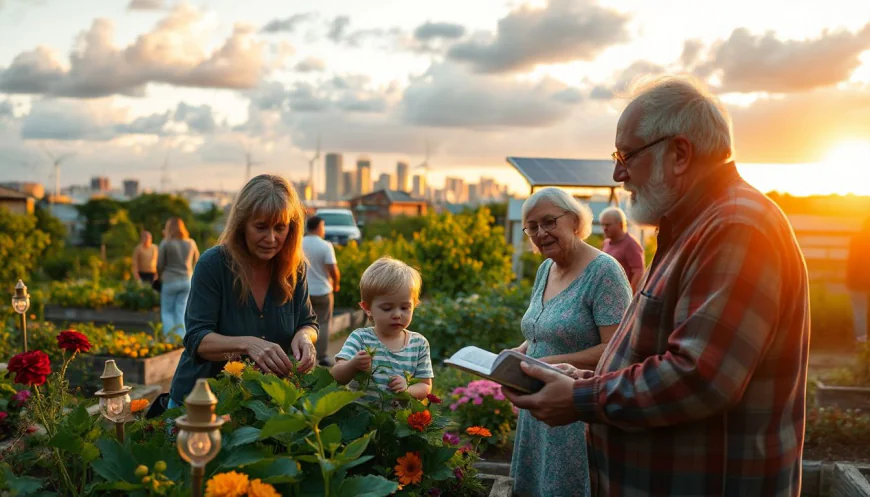Using Personal Stories to Humanize Climate Change Connecting Humanity to Climate Change Through Personal Narratives
Storytelling is one of the most powerful tools to make climate change real. When we share stories, we turn cold facts into something emotional and relatable. Instead of just numbers and charts, personal stories connect us to the real people affected. They remind us that climate change isn't just an environmental issue; it’s a human one. Hearing someone’s story can spark feelings like empathy and urgency. These stories can push us to act because they show how climate change hits close to home. When you see a neighbor or a family share their struggles, it can ignite a desire for change. Human stories aren’t just good stories — they can be catalysts that inspire climate solutions.

The Power of Personal Stories in Climate Change Communication
The Psychological Impact of Personal Narratives
Stories make climate change personal. They tap into our emotions and help us understand others’ situations. This connection builds empathy, making us care more. Research shows that storytelling is eight times more effective in changing behavior than dry facts or stats.
People remember stories longer too. When you hear about a family losing their home because of flooding, that image sticks with you more than a graph showing rising sea levels. Personal stories also break down the feeling that climate change is too big or distant to fix.
Going Beyond Statistics: Making Climate Change Relatable
Raw data often feels cold and disconnected. But stories put faces and voices to the numbers. Someone telling you how droughts ruined their crops makes the story more tangible. It’s easier to see the real-life toll of climate change when you hear how it affects people's daily lives.
These stories turn abstraction into reality. They show how climate change impacts health, job security, homes, and communities. When stories resonate, they motivate action far more than charts or pie graphs ever could.
Building Trust and Credibility
People trust stories from real folks. Personal experiences feel genuine and trustworthy. When community leaders or local residents share their struggles, their voices carry weight. They’re seen as credible because they’ve lived it.
Trusted voices make messages more believable. Sharing authentic stories from diverse backgrounds makes the bigger picture clearer — and more urgent — for everyone.
Strategies for Collecting and Sharing Personal Climate Stories
Identifying Authentic Voices
Reach out to people affected by climate change from all walks of life. Farmers, city residents, youth, elders — everyone has a story. Listen carefully and ask permission before sharing. Respect and honesty are key.
It’s important to be mindful and ethical. Always get consent and avoid putting anyone at risk. Stories should empower, not exploit.
Storytelling Platforms and Mediums
Share stories widely on social media, blogs, podcasts, or community events. Each platform offers unique opportunities. Photos and videos grab attention and make stories more powerful.
Visuals and multimedia help tell stories more impactfully. For example, a video of a flooded street can hit harder than a written piece.
Amplifying Underrepresented Perspectives
Many voices go unheard. Focus on marginalized communities often hit hardest by climate change. Their stories give a full picture of the crisis.
Create space for these voices. Ensure everyone’s experiences are included and valued. Diversity in stories creates a stronger, more inclusive climate movement.
Examples of Effective Climate Change Personal Stories
Community Impact in Coastal Regions
Take Louisiana, for example. Families living near the coast see rising sea levels every day. Their stories of lost homes and changing traditions make the crisis real. Sharing their experiences has helped rally support for flood defenses and climate policies.
Personal Health and Climate Change
A person with asthma or respiratory problems often tells a powerful story. Pollution and heat waves worsen their health. When people hear how climate change affects individual health, it makes the issue personal and urgent, especially for policymakers.
Youth and Climate Activism
Young activists, like Greta Thunberg, share stories of feeling worried about the future. Their personal motivations motivate others to join the cause. Their stories have helped push governments to act faster.
Incorporating Personal Stories into Climate Action Initiatives
Advocacy and Policy Change
Stories can sway politicians. When you share a personal tale during a campaign, it hits harder than stats alone. Personal stories have helped win policies that promote renewable energy or protect vulnerable neighborhoods.
Education and Community Engagement
Teachers and community leaders can include personal stories in lessons and workshops. These stories make climate change relatable and inspire local action. Initiatives rooted in real experiences foster stronger community bonds.
Corporate and Organizational Outreach
Businesses and NGOs should use authentic stories to connect with people. Sharing employee or community stories can boost support for sustainable practices. It builds trust and shows real commitment.
Best Practices and Actionable Tips for Effective Storytelling
- Be genuine; authenticity matters more than perfection.
- Use visuals — photos, videos, or artwork — to boost emotional impact.
- Respect privacy and cultural sensitivities.
- Host storytelling workshops to gather diverse voices.
- Track feedback and engagement to see what works best.
Conclusion: Human Stories as a Catalyst for Climate Action
Personal stories turn climate change from a distant problem into something tangible and urgent. They build empathy, trust, and motivate real change. Every voice matters when it comes to shaping our shared future.
By sharing diverse experiences, we can inspire others to act. Start today — listen, share, and amplify stories that matter. Together, these narratives have the power to spark the change our planet needs.



 VARSHITHA
VARSHITHA